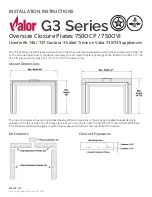
21
139435_A GZ
455
DV 8/28/12
6.5 High Altitude Adjustment
The decreased atmospheric pressure of higher altitudes
affects the heat value of gaseous fuels. Most gas
suppliers derate the gas intended for use at elevations
above 2000 feet. Check with your gas supplier before
performing derate adjustment to the burner.
This appliance may be adjusted for altitude over 2000 ft.
(610 - 1371 m) for natural gas or propane.
If the gas supplier does not derate fuels, install High
Altitude Adjustment Kit 157430 for Propane and Kit 157431
for Natural gas.
U.S & Canada per
ANSI Z21.88-2009•CSA 2.33-2009, CAN/CGA 2.17
For installations from 610-1370 meters (2000-4550 ft.)
the orifice sizes (DMS) for natural and propane gas are
#41 and #53 respectively. See data plate for additional
information. For high altitude installations consult the
local gas distributor or the authority having jurisdiction
for proper rating methods. If the installer must convert
the unit to adjust for varying altitudes, the information
sticker must be filled out and applied to the appliance at
the time of the conversion.
6.5.1 Derating Procedure
1.
Confirm that the injector identification stamp conforms to the
size specification noted above.
2. Use a 1/2” or 13 mm deep socket to remove the original orifice
and replace it with the one provided in the kit appropriate for
gas type. See fig.6.8, page 20.
3. Replace the burner and burner skirt.
4. Conduct gas leak and gas pressure tests as detailed on pages
16-17 of this manual.
5. Conduct system check and flame picture adjustments
as specified pages 24-25.
6. Fill out the appropriate information and apply the high
altitude conversion label provided to the rating plate
on the appliance. See fig. 6.10.
Figure 6.10. Hi gh Altitude Conversion Label.
This appliance has been converted for use at an
altitude of___________ .
Orifice Size: __________ Manifold Press. _______
Input Btu/Hr. _________ Fuel Type ___________
Date: ___/___/___ Converted by:_____________
Cet appreeil a été converti au _____ Injecteur_____
Pression à la tubulure d’alimentation ___________
Déoit calorifique ___________
Cet appareil est equippé pour des altitudes compries
entre 0 et 2000 pieds (0-610 m ) seulement.
Fuel Conversion, cont’d.
Figure 6.9.
Replace the regulator tower and reconnect the motor leads.
10. Replace the Burner Plate.
Engage the burner tube with the Air Shutter assembly.
Engage the slots on the right end with the support
brackets.
11. Replace the Valve Regulator.
Using a Torx T-20 screwdriver, remove the two screws
from the front of the regulator, (fig.6.10).
Disconnect
the motor lead at the splice connector and
replace the
regulator components with those from the conversion
kit. Reconnect the motor lead.
12. Install the identification labels
to the valve so that
they can be seen by any service technician.
Label A: apply to valve compartment floor.
Label B: apply to the rating plate attached to the back
of the stove.
Small Conversion Label: apply to valve.
13. Reassemble the stove,
apply gas to the system and
check for leaks using a soapy water solution or gas
detector.
NEVER USE AN OPEN FLAME TO CHECK FOR GAS LEAKS.
















































